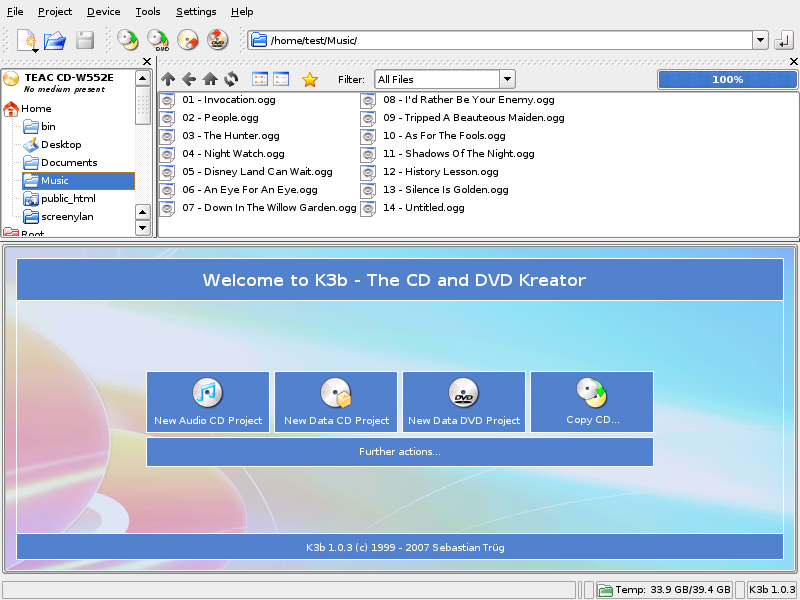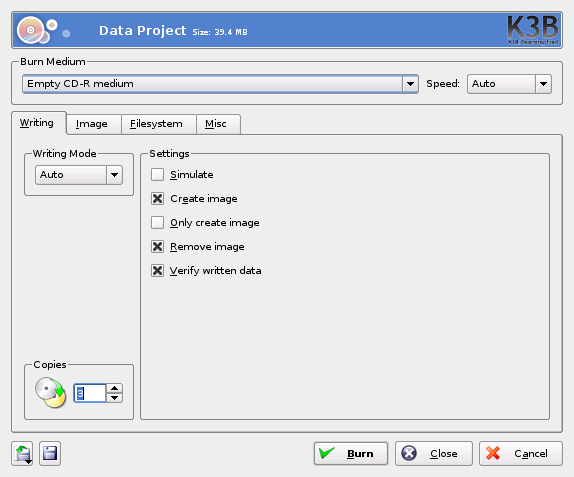19.1 Creating a Data CD or DVD
To create a data CD, go to . To create a data DVD, go to . The project view appears in the lower part of the window, as shown in Figure 19-1. Drag the desired directories or individual files from your home directory to the project folder and drop them there. Save the project under a name of your choice with .
Figure 19-1 Creating a New Data Project

Then select from the toolbar or hit Ctrl+B. A dialog with four tabs offering various options for writing the CD or DVD opens. See Figure 19-2.
Figure 19-2 Customizing the Burning Process

The tab has various settings for the burning device, the speed, and the burning options. The following options are offered here:
-
The detected medium and writer are displayed under this pop-up menu. If you have more than one writer installed, choose which one you want to use here. You can select the speed here too.
WARNING: Select the Writing Speed with Care
Normally, you should select , which chooses the maximum writing speed possible. However, if you increase this value but your system is not able to send the data fast enough, the likelihood of buffer underruns increases.
-
This option determines how the laser writes the CD or DVD. For CDs, there are three modes available: DAO (disk at once), TAO (track at once), and RAW. In DAO mode, the laser is not deactivated while the disk is written. This mode is recommended for the creation of audio CDs. In the TAO mode, a separate write process is used for each individual track. The RAW mode is not used very often, because the writer does not perform any data corrections. For DVDs, auto or DAO modes are available. Do not use DAO mode if you want to create multisession DVD.
We recommend you to select , because it allows K3b to use the most suitable settings.
-
This function can be used to check if your system supports the selected writing speed. The writing is performed with a deactivated laser to test the system.
-
If this option is enabled, an ISO image of the CD or DVD is created first. This image file is subsequently written to the CD or DVD. This option should be used on low performance systems. You can set the path for this file under on the tab. Checking this option also activates the option. If you want the image to be not deleted after burning is finished, uncheck that option.
-
If this option is enabled, the ISO image file is created but it is not subsequently written on CD or DVD. Use this option if you want to write the image on CD or DVD at a later time. To do this, use or . If this option is used, all other options in this section are deactivated.
-
Remove the temporary image file from hard disk when finished.
-
Check the integrity of the written data by comparing the MD5 sums of the original and the burned data.
The tab is useful only if the or the option is set. In this case, determine the file on which you want to write the ISO.
In the tab, set the . If you click , you can add more information about the project, such as its publisher and preparer, copyright information and the application and operating system used in the creation of this project. You are able to set the used and determine how and should be handled.
The tab contains two options. The first one, is available only for CDs. Here you can set up how data tracks should be written. In general, is considered the best suited method. The is used to append data to an already written but not finalized medium.
After adjusting all settings to your needs, start the actual burning process using . Alternatively, save these settings for future use and adjustment with .